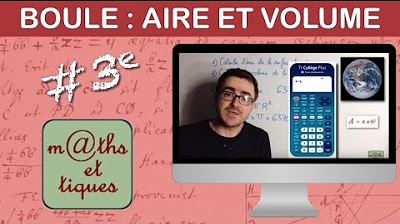Visualizing the Volume of a Sphere Formula | Deriving the Algebraic Formula With Animations
Summary
TLDRThis video explains the origin of the formula for the volume of a sphere. It begins by recalling that it takes two cones to fill a sphere with the same radius, then revisits the volume formulas for a cylinder and a cone. By analyzing the relationship between the radius and height of the cones and the sphere, the video simplifies the process to derive the well-known formula for the volume of a sphere: (4/3)πr³.
Takeaways
- 🌍 The formula for the volume of a sphere is derived from the geometric relationship between a sphere and two cones of the same radius.
- 📏 The volume of a cylinder is calculated by multiplying the area of its base (πr²) by its height.
- 🔺 The volume of a cone is one third of the volume of a cylinder with the same height and radius.
- 🔄 It takes two cones to fill a sphere with the same radius, implying that the height of the sphere is equal to the combined height of the two cones.
- 📐 The height of the cones is twice the radius of the sphere (2r = h), which simplifies the calculation of the sphere's volume.
- 🔢 The volume of a sphere is calculated by taking the volume of one cone and doubling it, considering the relationship between the cone's radius and the sphere's radius.
- 🧮 The mathematical simplification involves replacing the height (H) with 2R, leading to the expression 2/3πR³ for the volume of one cone.
- 🔄 By doubling the volume of one cone, the total volume for two cones (and thus the sphere) is 4/3πR³.
- 📘 The final formula for the volume of a sphere is 4πR³/3, which is a concise representation of the combined volumes of two cones that fit perfectly within the sphere.
Q & A
What is the main topic of the video?
-The main topic of the video is to discover the formula for the volume of a sphere.
How is the volume of a cylinder related to the area of its base?
-The volume of a cylinder is found by multiplying the area of its base, which is πr^2, by its height.
What is the relationship between the volume of a cone and the volume of a cylinder with the same height and radius?
-The volume of a cone is one-third of the volume of a cylinder with the same height and radius.
How many cones are needed to fill a sphere with the same radius according to the video?
-It takes two cones to fill a sphere with the same radius.
Why are the heights and radii of the two cones the same as those of the sphere?
-The heights and radii of the two cones are the same as those of the sphere because the cones are used to fill the sphere completely.
What is the mathematical relationship between the height of the cone and the radius of the sphere?
-The height of the cone is twice the radius of the sphere, or 2r.
How can the volume of a sphere be derived from the volume of two cones?
-The volume of a sphere can be derived by adding the volumes of two cones, each with a height and radius equal to that of the sphere.
What is the simplified expression for the volume of a sphere based on the script?
-The simplified expression for the volume of a sphere is (4/3)πr^3.
Why is the coefficient of the volume formula for a sphere 4/3?
-The coefficient 4/3 comes from adding the volumes of two cones, each with a volume of 2/3πr^3, resulting in 4/3πr^3 for the sphere.
What is the significance of the formula (4/3)πr^3 in the context of the video?
-The formula (4/3)πr^3 is the final derived formula for the volume of a sphere, which is the main focus of the video.
How does the video script help in understanding the derivation of the volume of a sphere?
-The video script helps by breaking down the process of deriving the volume of a sphere through the relationship with cylinders and cones, and by simplifying the mathematical expressions involved.
Outlines

This section is available to paid users only. Please upgrade to access this part.
Upgrade NowMindmap

This section is available to paid users only. Please upgrade to access this part.
Upgrade NowKeywords

This section is available to paid users only. Please upgrade to access this part.
Upgrade NowHighlights

This section is available to paid users only. Please upgrade to access this part.
Upgrade NowTranscripts

This section is available to paid users only. Please upgrade to access this part.
Upgrade NowBrowse More Related Video

Volume of a Sphere | MathHelp.com

Bangun Ruang Sisi Lengkung [Part 3] - Bola

LUAS PERMUKAAN DAN VOLUME BOLA - BANGUN RUANG SISI LENGKUNG (5) - MATEMATIKA SMP KELAS 9

Calculer l'aire et le volume d'une boule - Troisième

Buoyant Force Explained: Objects Floating on Fluids!

Cálculo de volumen y coordenadas de centroide I Ejemplo 1
5.0 / 5 (0 votes)